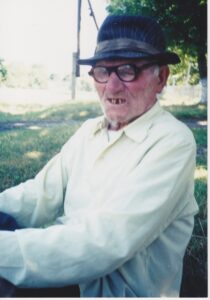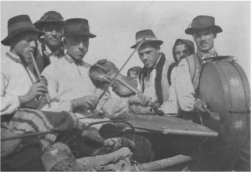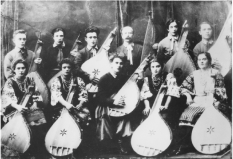—Where did your father sell his pottery?
Kateryna Kostiantynivna: He took them to Vilshana and Kharkiv. There was a market in Vilshana and private stores in Kharkiv where he supplied the pitchers.
—Were there many potters in the village?
Kateryna Kostiantynivna: Yes, many.
—Five to seven families, would you say?
Kateryna Kostiantynivna: I can’t say for sure, but probably more than five families. There were some in Valky, too.
…………………………………………………………………….
—Did you sometimes help your father make the pots?
Kateryna Kostiantynivna: No, I only helped with finishing. A pot was covered with tar; you’d buy the lead and ochre dye. The lead was melted. We helped around with these jobs.
—Both you and your brothers?
Kateryna Kostiantynivna: My brothers helped, too.
—Did your father do this in the fall or in the winter?
Kateryna Kostiantynivna: Whenever he had the time. He had seven hectares and had to work the land.
—Where would he dry the pots in the summer?
Kateryna Kostiantynivna: There were wooden planks, and we also dried them above the sleeping ledge of the oven.
—In the potter’s workshop or in the house?
Kateryna Kostiantynivna: No, the pots were not dried in the house because they would dampen the air.
—And in the summer?
Kateryna Kostiantynivna: In the summer, the pots dry outside in the sun.
—Was anything painted on them or any reliefs introduced?
Kateryna Kostiantynivna: Not back in the day. Some were made of red clay, and on them other specialists used to paint patterns.
—Were the pots glazed?
Kateryna Kostiantynivna: Yes. You’d cover the pot with tar, then melt the lead, and add two or three glasses of ochre and one glass of lead. You’d use a tool to spread the tar and powder the pot with the mixture. We used to do this kind of work.
—What did your father give you for this work?
Kateryna Kostiantynivna: What did he give me? He would make a wooden bed (we still have it), a cabinet, and a dresser.
—Did he make them on his own?
Kateryna Kostiantynivna: Oh, no. He bought the wood planks, and the masters came to our house to make furniture. My father gave me furniture as a gift when I was getting married.
—Did your father have horses and take pots to the market to sell?
Kateryna Kostiantynivna: He didn’t sell them; he would only deliver them to Vilshana or Kharkiv.
—Where did he sell them in Kharkiv?
Kateryna Kostiantynivna: There were resellers.
—What were the taxes like?
Kateryna Kostiantynivna: I don’t know this.
Kateryna Kostiantynivna Zoria (Kharkiv region)
—How much were you paid by the kolhosp?
Kateryna Kostiantynivna: They used marks to record the days worked. You know, then they would say, “You haven’t done enough work to earn a mark.” Eh, the kind of work we did and how we did it. One shouldn’t work like this and people shouldn’t be forced to work so much because the people today won’t survive it like we did.
—Did you receive wheat and corn at the time?
Kateryna Kostiantynivna: Yes, we did, but what use was that? The minimum you had to work at the time was three hundred workdays. My old man and I did up to seven hundred workdays. He did the sawing, and I did various jobs, wherever they sent me and in the vegetable garden, too. They recorded that I worked eleven days. After my eye was removed, I didn’t work anymore; I had a disability of the second category.
—Eleven workdays per year?
Kateryna Kostiantynivna: No, per month. What did they give you per workday? When the kolhosp picked up, they started giving more. Then they determined that my disability was the third category and told me to go back to work.
—Did you work during World War II?
Kateryna Kostiantynivna: No.
—Where did you work afterwards?
Kateryna Kostiantynivna: In the vegetable garden brigade.
Kateryna Kostiantynivna Zoria (Kharkiv region)
—When you were young, how did you party? Did you go to vechornytsi?
Kateryna Kostiantynivna: When I was young, we partied outside and didn’t have any vechornytsi inside. We didn’t rent a house for that.
—Did girls get together to spin yarn?
Kateryna Kostiantynivna: No, each did that in her own house. Everyone took care of their own business.
—What kind of clothes did you use to make?
Kateryna Kostiantynivna: Clothes for everyone: a skirt, a blouse, and some linen. When I grew up, I had a jacket. We also made suede jackets and men’s and women’s coats—well, we made our own clothes.
Zoria Kateryna Kostiantynivna (Kharkiv region)
—When did the people start organizing a club in Pisky?
Kateryna Kostiantynivna: I went one time. My mother said, “What kind of a show was there?” — “Quite a show. They were breaking an icon.” She said, “I don’t want to see you go there ever again.”
—Were they showing people how to break an icon?
Kateryna Kostiantynivna: I don’t know. They were saying something about God, breaking icons, and throwing them out; I don’t remember. My mother heard more details.
—Was this done by Komsomol members?
Kateryna Kostiantynivna: Yes. They were doing well, but my mother didn’t like it.
—Were they locals or newcomers?
Kateryna Kostiantynivna: Locals.





